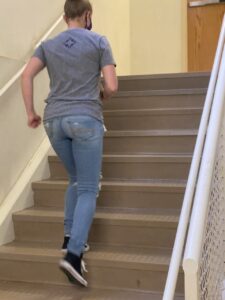The four flights of stairs inside Centennial Hall brew a consistent frustration among faculty, staff and students. It is a common sight to see individuals out of breath after reaching the top of the second flight, no matter who it is or their physical fitness making the trek. If it has nothing to do with who is climbing the stairs, then what is it that makes them so unbearable?
Amanda Beard, assistant professor of health fitness and sports science, uses the stairs as an example of how the body uses ATP (the main energy form for our cells) in her health fitness classes. She explains that the system in which our body uses ATP is also considered the phosphagen system, in which our body is able to utilize energy already stored within our muscle fibers to do movements such as walking up stairs. The body uses stored energy for about twelve seconds, so roughly one full flight of stairs.

Jenia Freewalt running up Centennial steps during set 2 of the experiment. Photo by Payton Stephens.
Once the energy already stored in your muscles has been used up, the second phase begins, thus switching from the phosphagen system to the glycolytic system, which lasts up to the two minute mark. When the body has been in motion for 30-50 seconds, the common burning in the legs and shortness of breath occurs due to lactic acid buildup as the body is trying to create more ATP energy to keep going.
The Centennial stairs are a total of 75 steps from the basement to the third floor, making the total time to climb the stairs around 50 seconds. After having the body in constant motion for a full 50 seconds, the body has already sent signals of increased respiration.
“When we get out of breath, it’s not because the body is lacking oxygen,” Beard said. “It’s because we have too much carbon dioxide buildup. So, when we change the depth or frequency of our breath it is really to get rid of the carbon dioxide.”
Jenia Freewalt, a freshman art education major, participated in the experiment testing how our pulse and air flow changes when climbing up the Centennial stairs. Freewalt is a distance runner on Bluffton’s Cross Country team, meaning she has experience pacing herself.
“I have never been a fan of stairs, I always try to avoid them,” Freewalt said. “And there is no avoiding the Centennial stairs. As a student athlete who runs cross country and track, these stairs still get to me.”
The experiment conducted was done in three sets, two used to measure heart rate and one to measure peak respiratory flow. The sets measuring heart rate were done once walking and once running up the steps, seeing how long it would take for Freewalt’s pulse to return to normal after each set.
| Set | Pulse | Recovery Time (Seconds) |
| Original | 75 | None |
| Walking | 114 | 34 |
| Running | 134 | 28 |
After data collection, it was clear that the faster you go up the stairs, the quicker Freewalt was able to recover. This is possible since she was able to climb more stairs in the first 12 seconds when running, making her amount of time creating ATP minimize.
The last set of data was done regarding peak respiratory flow when climbing the stairs. Freewalt stopped every 10 seconds to use the peak flow meter, the data showing her air flow decrease quickly before rising once again.
| Time | Air Flow (L/min) |
| Original | 400 |
| 10 seconds | 345 |
| 20 seconds | 364 |
| 30 seconds | 375 |
| 40 seconds | 405 |
Beard advises people to get into a breathing rhythm as a way to conquer these stairs. Possibly the act of exhalation for four or five seconds and only inhaling for two or three. She recommends starting the pattern before starting to climb the steps, then keeping the rhythm throughout walking up the steps.






